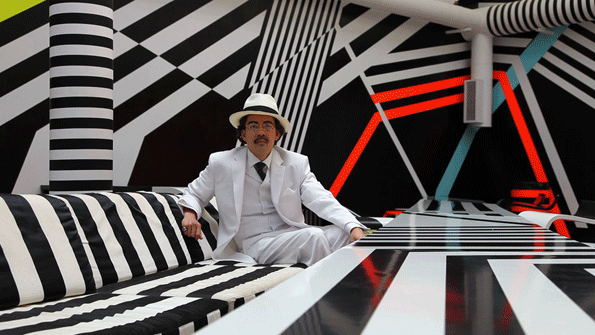LIFE AND DEATH IN VENICE /
LEBEN UND TOD IN VENEDIG /
VITA E MORTE A VENEZIA
3 channel video installation
16:08 mins loop
2010
LIFE AND DEATH IN VENICE /
LEBEN UND TOD IN VENEDIG /
VITA E MORTE A VENEZIA
3 channel video installation
16:08 mins loop
2010
 生死威尼斯
生死威尼斯
3频录像装置
16分钟与8分钟循环
2010年
在另一件把经典“腐化”的作品中,黄汉明相中了卢奇诺·维斯康蒂的《死于威尼斯》作为目标,这次他一人分饰两角—历遍苦痛的中年艺术家古斯塔夫·冯·阿森巴赫,以及他贪恋的美少年塔奇奥。在黄汉明的《生死威尼斯》版本里,故事的背景设定在21世纪的威尼斯—主角们漫步于第53届威尼斯双年展的展场中—并再次使用了分割屏幕的方法,只不过这次回避了原始影片的画面,以便两个角色都能出现在屏幕上。分割屏幕所导致的画面孤立更加强调了情形中明显的荒谬感。画面左侧,冯·阿森巴赫火热的凝视与塔奇奥无神且游离的目光形成了幽默的反差。这部影片中两个角色间的交换仅限于眼神—男孩的闪躲,男人的痴迷与吞噬。
 LIFE AND DEATH IN VENICE /
LIFE AND DEATH IN VENICE /
LEBEN UND TOD IN VENEDIG /
VITA E MORTE A VENEZIA
3 channel video installation
16:08 mins loop
2010
Ming Wong’s 3-screen video installation is a revisitation of Death in Venice – Luchino Visconti’s 1971 film version of Thomas Mann’s 1912 novella.
On opposite screens the artist performs the roles of both the ageing composer/writer Gustav von Aschenbach as well as Tadzio, the adolescent boy whose uncorrupted youth and beauty mirrors the older man’s state of crisis and impending death.
Entirely self-directed, produced and conceived whilst his presentation for the Singapore Pavilion at the 53rd Venice Biennale was still on-going, the fi lm was shot in several original locations of the book/film as well as against appropriated backdrops of artworks in the Venice Biennale.
The ‘Adagietto’ from Gustav Mahler’s Symphony no.5 – the theme tune of Visconti’s film – provides the soundtrack, via a flawed performance by the artist himself on piano.